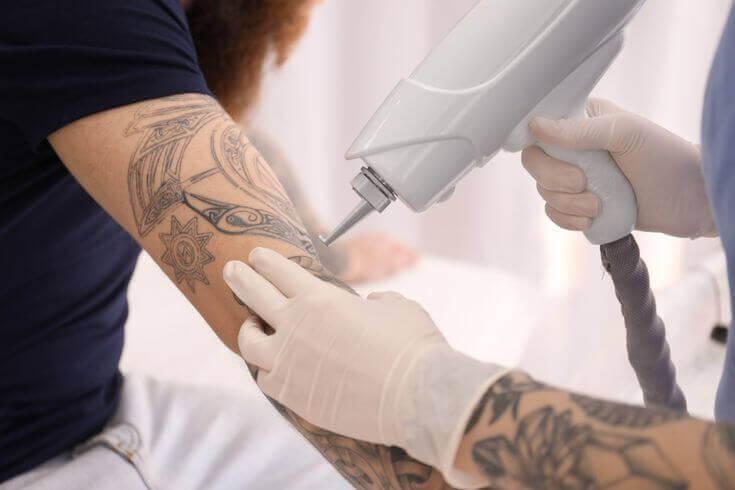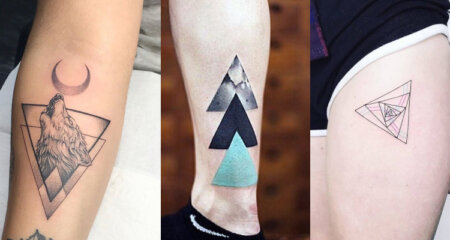
Why Are Tattoos Permanent and How Tattoo Removal Works
Posted on
Tattoo ink is injected into the skin with a mechanized needle and stored in the dermis, the second layer of the skin. The pigment alerts the immune system and sends cells to the affected area. Some of these cells destroy the pigment and others absorb the ink which makes the tattoo permanent.
You might consider tattoo removal if you regret a tattoo or you’re unhappy with the appearance of your tattoo. Perhaps the tattoo has faded or blurred, or you decide that the tattoo doesn’t fit your current image.
Also, it is important to remove the tattoo if you develop an allergic reaction or other complications, such as an infection.
There are many ways to remove the tattoo, but the safest method is through laser removal.
The laser light applied to the skin heats up and breaks the ink that it reaches first. The shallowest layers are taken out before proceeding to the innermost layers of the skin. The number of treatments depends on the depths of the ink in a tattoo. More treatments are required to remove dark or bold tattoos than shaded tattoos with lower concentrations of ink.
What Makes Tattoos Permanent?

When a tattoo needle penetrates the skin, it tears through the epidermis, the external layer of skin, and sheds ink in the dermis, the internal layer of skin, which is filled with blood vessels, nerves, collagen fibers, and glands.
The ink deposited in the skin signals the immune system to send cells to the affected area. Some ink pigments are destroyed by the macrophage cells, while others remain on the dermal cells, called fibroblasts, along with the color. These fibroblasts don’t peel off when the epidermis regenerates, instead they remain in the skin till they expire. The remains are absorbed by other live fibroblasts along with the color which makes the tattoo permanent.
How Do Lasers Remove Tattoos?

You might have seen an old tattoo that is partly faded. Tattoos lose its luster over time because the immune system of the body sees it as an impurity and tries to remove the ink.
The application of laser technology hastens the removal process by breaking the tattoo into tiny fragments that can be easily discarded.
Training the tattoo ink
Every color conceivable can be seen in a tattoo, each color reacts to different wavelengths of light at varied rates. Since the aim of laser tattoo removal is to dissolve the ink in the tattoo using laser light, the wavelength that will be used should be well-absorbed by the tattoo.
For instance, a green laser light will heat up and shatter a red ink tattoo since the 532 nm wavelength of laser light looks green enough to treat a red tattoo.
You need a variety of laser wavelengths to treat multiple tattoo colors. Basic wavelengths for tattoo removal are 1064 nm and 532 nm with 95% efficacy. Some professionals keep 755 nm and 694 nm handy to treat rare tattoo dyes like light blue or green.
Also See: Can a Tattoo be Removed Completely?
Laser tattoo removal machines
A tattoo owner has many ways to remove the body art; the skin can be extracted, rubbed away, application of topical, or through laser removal. Most doctors prefer laser tattoo removal since it is an effective and non-invasive method to get rid of annoying ink. The types of laser tattoo removal machines
are…
⇒ Q-switching
Q-switched lasers emit powerful, brief pulses of energy lasting a few nanoseconds.
Tattoo ink particles, usually nanometers in diameter, warm up and shatter when the heat is applied for a short period of time. While skin cells are much larger and need to be heated for a longer period to be broken. In essence, Q-switched laser pulse is capable of shattering the tattoo ink without damaging the skin cells.
⇒ Picosecond
A picosecond is the machine preferred by practitioners since it is fast and reliable. This device can produce wavelengths in the range of 532 nm – 755 nm and 1064 nm and can deliver energy in the astonishing range of 300 to 750 ps.
⇒ Nanosecond
This device typically produces a wavelength of 1064 nm and energy in the range of 1000 µ J. The result is extreme cavitation and heat.
What tattoos can be removed?
Tattoos can be removed, but not always. Many factors come into play that cannot be controlled by the specialist such as…
⇒ Damage to the skin
It can be removed if there is an absence of any skin damage. Tattoos done by an inexperienced tattooist or a tattoo removal treated improperly by a clinic can result in scarring that can cause the laser light to be reflected and not absorbed, leaving an incomplete tattoo removal.
⇒ The type of ink
There are myriad types of inks made in different ways. Ink manufacturers often change the chemical components and some will not respond well with laser removal.
⇒ The color of ink
There are colors that are difficult to remove like black, brown, blue, and green. Large, dark, and colorful tattoos take more hours and costlier to remove than small and less colorful ones. Also, it is easier to remove older and amateur tattoos than newer ones.
What to Expect in your Laser Tattoo Removal Session?
Before a tattoo removal session, schedule a tattoo consultation with a specialist for an evaluation of your tattoo and advice on expectations during the process. The removal technique will depend on the color of your skin and the depth of the tattoo color. The number of visits to the clinic hangs on the size, colors, and age of your tattoo.
Expect these things to happen during the session:
- Local anesthetic will be applied to numb the tattooed area.
- A pair of protective eye shields will be given to you to protect your eyes from laser light.
- Your skin’s reaction to the laser will be tested to select the most effective energy treatment that will work for you.
- Pulses of intense light will be applied to the top layers of your skin that will be absorbed by the tattoo dye.
- It will hurt and treatment will last from 30 seconds to 15 minutes.
Alternative Tattoo Removal Methods
Today, laser tattoo removal is the most widespread method of removing unwanted body ink. But there are other methods available to people who want the tattoo removed from their body. Here are some of the alternatives:
⇒ Saline tattoo removal
Saline is a solution of salt and water that is injected into the tattoo area. Once the solution is implanted in the dermis it breaks the pigment and pulls it to the outer surface. The displaced pigment turns into a scab and peels off making the tattoo look lighter. A number of sessions follow until the desired result is achieved.
⇒ Dermabrasion
Dermabrasion is an exfoliating technique that uses a fast-moving brush to extract the outer layer of the skin, usually on the face. It peels the top layer of the skin to remove the pigment and the affected skin and often leaves the skin chafed and susceptible to infection. Consult your doctor before proceeding with this method.
⇒ Tattoo removal creams
Tattoo creams are applied to the tattoo hoping that it will rub off the ink. There’s little evidence that it works, at best it can make the tattoo fade away.
⇒ Excision
Excision is a surgical process using a scalpel to cut a portion of the skin with tattoo ink. The skin around the tattoo is sutured to close the lesion.







